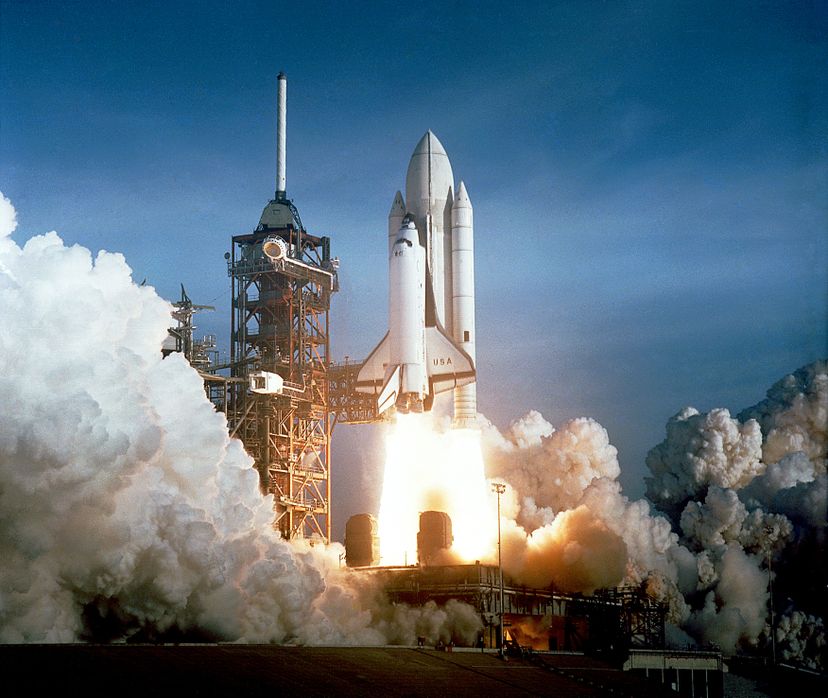
About This Quiz
At its best, the space shuttle is the embodiment of 20th-century scientific progress. At its worst, the shuttle is a symbol of the dangers that come with space travel. Take this quiz to see how much you know about the space shuttle program.To achieve orbit, a space shuttle needs to reach about 18,000 miles per hour as it speeds out of Earth's atmosphere.
While in orbit, a space shuttle travels at about 17,500 miles per hour (28,200 kilometers per hour).
While traveling 17,500 miles per hour around Earth, crew members can see a sunrise or sunset every 45 minutes.
Advertisement
A typical shuttle mission lasts seven to eight days from launch to landing, though they've been known to last up to two weeks, depending on the mission's objectives.
The longest space shuttle mission was 17 days, 15 hours, 53 minutes, 18 secs, between Nov. 19, 1995, and Dec. 7, 1996.
The combined mileage of all five orbiters — 513.7 million miles (826.7 million kilometers) — is 1.3 times greater than the distance between Earth to Jupiter.
Advertisement
Discovery, flown between 1984 and 2011, traveled 148.2 million miles (238.5 million kilometers) during its 39 missions.
On Oct. 29, 1998, President Bill Clinton watched John Glenn's return to space on the Mercury STS-95 flight from Kennedy Space Center in Florida.
The SRBs provide about 71 percent of the main force necessary to lift a shuttle into space. The remaining 29 percent of the thrust is supplied by the orbiter's three main engines.
Advertisement
The external fuel tank of the shuttle's main engines is mostly filled with liquid hydrogen. While the engines burn both liquid hydrogen and liquid oxygen, these substances are stored in a 6-1 ratio in favor of liquid hydrogen. The engines draw enough liquid hydrogen and liquid oxygen to empty a family swimming pool every 10 seconds.
The polyisocyanurate foam insulation that covers the external fuel tank is crucial to the shuttle's liftoff. However, it doesn't play a role in stabilizing the tank after ignition. Its three primary purposes are to keep the fuel cold, protect the fuel from heat that builds up on the exterior of the fuel tank in flight and minimize ice formation.
The main engines are housed in the orbiter's aft fuselage. The forward fuselage contains support equipment for the crew, while the RCS module stores forward rocket jets for steering the orbiter.
Advertisement
The thermal protection system contains more than 30,000 tiles made from sand.
STS is an acronym for "space transportation system," the official name of the space shuttle program.
President Richard M. Nixon announced that NASA would develop a reusable space shuttle or space transportation system (STS) in 1972. The shuttle would consist of an orbiter attached to solid rocket boosters and an external fuel tank, and the prime contract was awarded to Rockwell International.
Advertisement
If all goes well, the shuttle's main engines will shut down at T plus 8.5 minutes of the launch. About 30 seconds later, the fuel tank will separate from the orbiter, burning when it re-enters the atmosphere. The shuttle engines are at maximum throttle several minutes earlier in the course of a launch, usually at about T plus 60 seconds.
On Jan. 28, 1986, a faulty seal on one of Challenger's solid rocket boosters failed in the cold temperatures.
Communication between mission control in Houston and the shuttle orbiter is a three-step process. Basically, mission control will send signals to a 60-foot (18-meter) radio antenna at a test facility in New Mexico. This antenna will relay the signals to a pair of tracking and data relay satellites in orbit 22,300 miles (35,900 kilometers) above Earth. The satellites will relay the signals to the space shuttle. The system also works in reverse; when the orbiter contacts mission control, the signal goes from the satellites to the test facility to Houston.
Advertisement
NASA uses 107 infrared, high-speed digital video, high-definition TV, 35-millimeter and 16-millimeter cameras around the launch pad to detect possible damage to the shuttle that occurs after liftoff. Ten sites within 40 miles (64 kilometers) of liftoff are also equipped with cameras to detect possible damage, and there are also cameras on the external fuel tank, on the solid rockets boosters and in the orbiter itself.
Astronaut Michael Massimino, as a crewmember on Atlantis, was the first to tweet from space.
True and false on this one. The ET was originally painted white during the first 2 missions but left unpainted from then on.
Advertisement
The external fuel tank can't be reused because it's destroyed in the atmosphere after launch.
A crew could be from five to seven people.
More than 600 people have flown on NASA space shuttle missions.
Advertisement
It would take the energy equivalent to 23 Hoover Dams to equal that produced by the shuttle's three main engines.
Columbia broke apart over Texas after its damaged heat shield was unable to protect the shuttle and its crew as it attempted to land.
A version of "God Bless America" sung by Kate Smith played on the last morning of the final shuttle mission. Other songs played during the STS-135 mission include "Rocket Man" by Elton John and "Run the World (Girls)" by Beyonce.
Advertisement
A 12-inch (30-centimeter) Buzz Lightyear doll flew to the ISS as part of an educational and outreach program between NASA and Disney.
Buzz Lightyear spent 468 days in space, leaving on Discovery on May 31, 2008, and returning Sept. 11, 2009.
NASA's space shuttle program shuttered on Aug. 31, 2011.
Advertisement